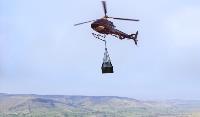 Add My Company
Add My Company
Sign In

An innovative device that simultaneously senses a helicopter’s position and weighs the load it is carrying has helped a 50-year landscape conservation project successfully reaching its first five-year milestone.
The HeliNav TrackMaster is a simple and accurate system that simultaneously monitors underslung loads and logs actual flight paths while also providing navigational guidance.
The UK is home to 15% of the world upland peat moors and much of it is in danger from erosion, overgrazing, drying out and brush fires. These areas are essential to the wider ecological balance, providing a specialised wildlife habitat, absorbing carbon dioxide and storing water that slowly feeds down to the lower landscapes, filling reservoirs and maintaining the water table.
An epic programme that brings together the expertise of the National Parks, the National Trust, Natural England and many, many specialist contractors is now underway to restore these moors to their natural state and protect their vital ecosystems. In order to get them back into good health, huge amounts of conservation work are being planned, which will take decades to bed in and for the habitat to start to turn around.
On Kinder Scout in the Peak District, probably Britain’s most famous upland moor, a five-year project began in 2011 to block gullies and hold back the rainwater that so-generously falls on the plateau top. At the same time revegetation has been undertaken, which over time will encourage peat to form. Brush, or cut heather from carefully selected donor sites, is spread about on the moor, its branches and roots forming a meshwork that helps retain the peat and prevents it from being washed away. The heather is also rich in its own seed, other seeds, fungi, microbial and insect life, and even small reptiles and mammals. It will also attract ground nesting birds and, long-term, encourage the immigration of larger animals.
The physical work for this stage of the project will be completed by 2016, by which time it will have required a great many helicopter flights to bring up boulders and rubble to form the gully blocking dams, to place loads of brush for manual distribution and to spray-seed the vegetation.
This in-flight working is being undertaken by Heli-Lift Services of Oxford, one of the UK’s and Europe's premiere helicopter operating organisations. It has worked on many similar projects, in agriculture and surveying, and has played a pivotal (if often unseen) role in the production of many films and TV advertisements.
IMAGE: Sensor flies conservation into new levels of control
Over the last few years it has also worked closely with another Oxfordshire company, Sensor Technology Ltd, to develop, test and prove HeliNav TrackMaster. The concept behind HeliNav TrackMaster is based on incorporating a strain gauge into the cargo hook that carries a helicopter’s underslung load.
The wireless Load Sensor is a strain gauge-based stainless steel tension type sensor. It has the capability of wirelessly transmitting its data to a readout where it both displays live readings and records them to build up an exact profile of each operation. Its inbuilt 32MBit memory can hold up to 280 hours of data, which can then be downloaded to a PC via its USB cable. The Load Sensor transmits using the worldwide licence-free frequency of 2.4GHz using two built-in antennae.
The readouts can be cockpit-mounted for the pilot’s use or handheld by an assistant on the ground (in fact, signals can even be transmitted to multiple control units simultaneously).
The controller logs the weight of the load and also the distance travelled, so that the helicopter operator can provide the client with accurate work reports and precise billing. The controller also uses an onboard GPS (global positioning system), inclinometer and accelerometer to help plot flight paths, flight times, fuel requirements, etc.
For seed-spraying and similar operations, the controller can optimise the flight path to ensure total, but even, coverage over the whole target area. For this, the pilot starts by flying around the periphery of the area, while the controller automatically records the flight path. When the helicopter returns to the start point, the controller is able to use shape recognition software to analyse the area enclosed and calculate the shortest flight route to cover the whole field. The pilot can add a further refinement by overflying features such as lakes and barns, and logging them so that spraying stops while the helicopter passes overhead on its working run.
Stuart Ring, Chief Pilot of Heli-Lift, says HeliNav TrackMaster brings a level of precision to operations such as the Kinder Scout project that would previously have been almost unimaginable. “Originally we would have so little operational data that we had only a basic idea of how much work we had actually done. Thus our billings, maintenance, etc. were based on time charges and estimations of loads. Now we can measure loads precisely and know exactly what distance we have flown.
"When Sensor Technology originally approached us to test their new equipment, we thought it sounded pretty good, but little did we know that it would eventually play such a major role in giving us a competitive edge in our global industry."
For more information on Sensor flies conservation into new levels of control talk to Sensor Technology Ltd
Enquire Now
List your company on FindTheNeedle.

